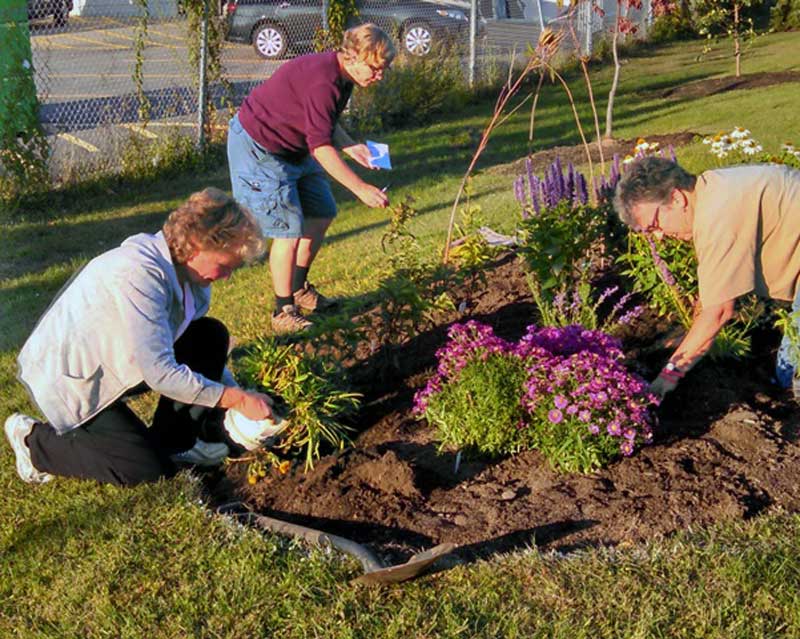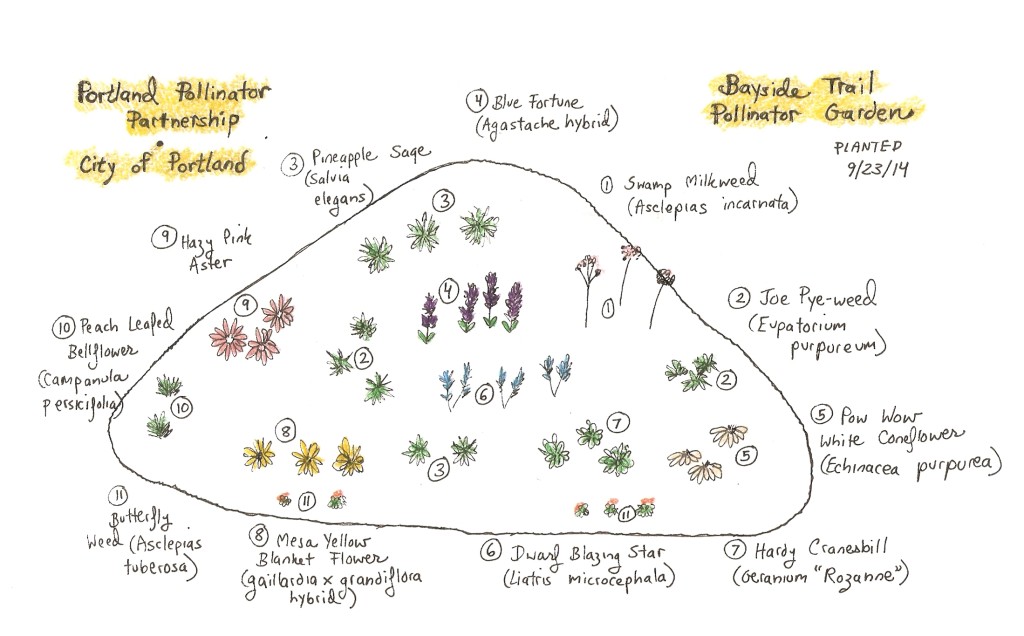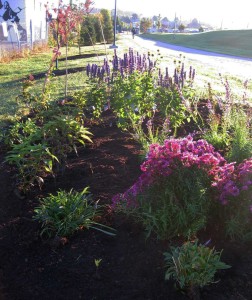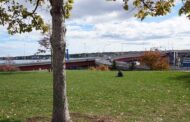The Portland Pollinator Partnership is hosted by the Bayside Neighborhood Association (BNA), and its partners include the City, Cultivating Community, Portland Trails, the West End Neighborhood Association and many others. Their goal is to increase and protect pollinator habitat.
WEN editor Tony Zeli interviewed BNA’s Annie Wadleigh about the Portland Pollinator Partnership (PPP) and their efforts.
Why did the pollinator group form?
Portland Pollinator Partnership was formed from a discussion that took place at a Bayside Neighborhood Association meeting about possible Bayside Trail amenities. Someone mentioned “bee walls,” which are wooden structures constructed to provide habitat for wild bees. A vision evolved of how the Bayside Trail would be an ideal place to establish pollinator habitat, and how Portland itself could become a model of a pollinator-friendly urban environment. The PPP was born and meetings began last April.
Are bees in Maine in trouble?
Bees everywhere are in trouble, both wild and honey bees, not just in Maine, but around the world. There are many theories about their decline, but there is substantial scientific evidence that their decline is a combination of agricultural and urban insecticide and pesticide use and loss of natural habitats.
A core part of our mission is to educate people about how beautiful native and/or chemical-free landscapes can be and how important they are to sustaining our wildlife and pollinators.
In many cases they are lower maintenance and more sustainable as well. It may seem strange to think of an urban setting as an optimal place for pollinators, but actually urban areas such as Portland, which has a surprising amount of “green” space, can play a key role in revitalizing these fragile creatures.
What has Pollinator Partnership achieved so far?
Last fall, PPP planted our first Pollinator Garden on the Bayside Trail, in partnership with the City of Portland. It is located near the former Maine Rock Gym/Trader Joe’s.

Susan McCloskey, Annie Wadleigh and Phyllis Reames helping to plant the first pollinator garden. Photo by Donna Herczeg.
We hope to expand that garden this year and work with the City of Portland to create more pollinator gardens throughout the city, as well as more “low mow” areas.
We have also been working with Heather McCargo from the Wild Seed Project to incorporate native plants. With Heather we are developing an informative handout of pollinator plants we recommend to help community groups and individuals create their own pollinator gardens.
Are there plans to push the city for policy changes?
We are very interested in Councilor Marshall’s proposed [pesticide ban] ordinance and support any initiative to limit or eradicate the use of pesticides in Portland. Although we haven’t been working with him directly, our nonprofit sponsor is the Organic Consumers Association, which was instrumental in working to help pass the recent pesticide ban in Ogunquit.
We believe education is key; many businesses and homeowners hire landscape companies and do not fully understand what chemicals are being used and how toxic they are to the environment, including wildlife, pets, children, and adults.
The irony is that much of this non-organic landscape, garden and lawn treatment is largely unnecessary and tends to create long-term ecological havoc.
Times are changing, however. The days of the “golf-course” lawn, which costs a fortune to maintain and has no birds, butterflies or bees, are numbered.
What would you say to anyone who calls native flower species, “weeds”?
In a sense, there is no such thing as a weed. Weeds are human inventions. The actual definition of a weed is “a wild plant growing where it is not wanted and in competition with cultivated plants.” So this is really a human aesthetic.
As Ralph Waldo Emerson, said, “What is a weed? A plant whose virtues have not yet been discovered.”
It’s a very anthropocentric, or human-based idea of beauty. Of course most of us want to plant an attractive, useful garden, whether that means vegetables, flowers, herbs, or a mixture. Yet where do our preferences come from?
Ironically, many of the cultivated or “designer” plants have crowded out the native plants that our pollinators depend on. Perhaps they are the real weeds!
Again, education is key. Once people learn about the importance of native plants and how many lovely choices are out there, they might be prouder of their pollinator-friendly garden than constructing something with exotic species.
What is the difference between Milkweed and an exotic rose? It is one of perception. Milkweed is a great example of a “useless” weed that used to grow freely but was decimated by pesticides, leading to the extreme decline of Monarch butterflies.
PPP recommends growing a range of native plants, in clusters, in a variety of colors, to provide the best habitat for pollinators.
I can envision a future in which the “picture-perfect” lawn or landscape, sustained through pesticides, leaf-blowers, and other costly treatments, is actually perceived as looking ugly. For many of us, that future has already arrived.








1 Comments
Anthony Zeli
Big thanks for Annie Wadleigh spending time with the West End News to share the Pollinators Partnership’s story.